(i) GDP
In 2005, Tibet entered the best era of economic and social development, with it's GDP totaling 25.121 billion Yuan, and it's per capita GDP reaching 9,114 yuan, exceeding 1,000 USD$.
Contribution to GDP of the Three Industries

Gross Industrial Production of Tibet (10,000 yuan)
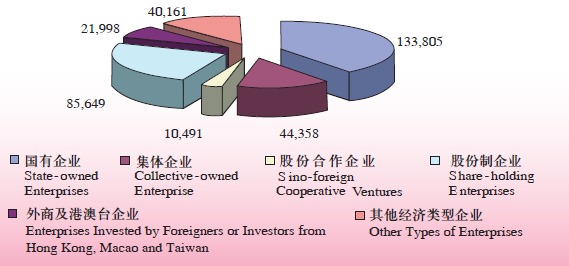
(ii)Agriculture & Industry
Agriculture
In 2005, the total planting area of crops was 3.5226 million mu, among which the planting area of grains was 2.6652 million mu, cash crops 0.7133 million mu, and fodder-crops 0.3715 million mu. The main crops included highland barley wild oat, wheat, rape, vegetables, etc. In 2005, the amount of livestock on hand was 24.15 million. The output of meat, milk and wool reached 0.2146 million tons, 0.2698 million tons, 9,944 tons respectively.
Industry
The industrial production had been growing very fast and steadily. The sales volume of main industrial corporations was 2,560.11 million yuan. The output of main products, including mining products, such as copper, gold, boron, lead, and zinc, as well as processing-products of farming and livestock, and the Tibetan medicine had been growing faster. The main industrial corporations refer to Yulong Copper Mine, Xiongmei Copper Mine, Zabuduo Copper Mine, Chaka Boron and Magnesium Mine, Zhabuye Lake salt mine, Qizheng Tibetan medicine, Tibet Tibetan Medicine Co. LTD., Tibet Rhodiola Pharmaceutical Holding Company.
(iii)Data on Commerce
Total Volume of Retail Sales for Social Consumer Goods
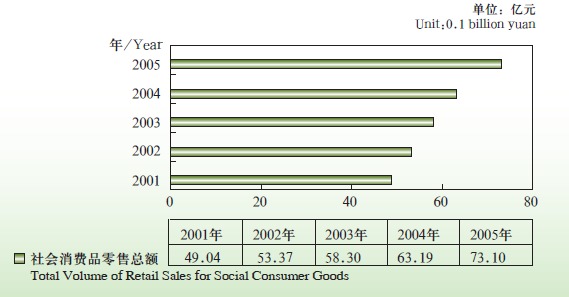
Foreign Trade
According to the customs statistics, the total value of import and export was US $ 205.39 million, in which the export value was US $ 165.31 million, and the import value was US $40.08 million. Border trade was developing very fast. The total value of border trade reached US $122.17 million, accounting for 59.48% of the total value of foreign trade.
Total Value of Foreign Trade 2000-2005
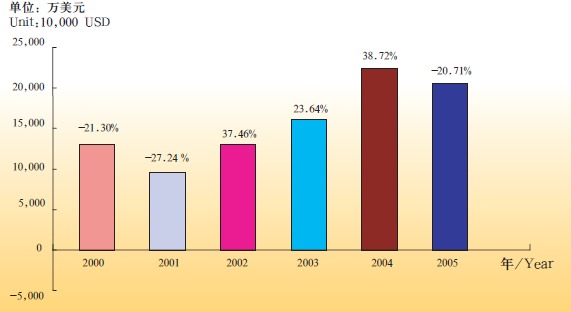
Graph of Methods of Conducting Trade in 2005
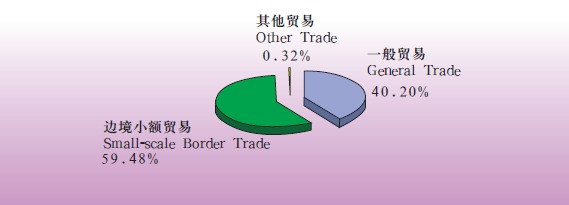
Utilization of Foreign Investment
In 2005, 16 foreign-invested enterprises were approved, with contracted value of US $ 33.0424 million, and the actually used value of US $ 11.5099 million.
(iv) Main Resources
Water Resources
According to statistics, the total volume of water resources in Tibet is 448.2 billion m3 (except for underground water). The water volume per capita and per mu ranks the first in China. The exploitable water volume is 56.60 million kilowatt, ranking the first place in China, accounting for 17.1% of the total volume of China. And the exploited water resources is 0.5 million kilowatt, accounting for 8.83% of the exploitable water volume.
Forest Resources
There is 910 million mu of woodland. The amount of wood storage is 2.084 billion m3, ranking the first all over China. The forest area of southeast of Tibet is a composition part of the Southwest Forest Area, which is China's second largest forest area.
Geothermal Resources
The deposits volume of geothermal resources in Tibet ranks the first in China. And the Yangbajing Geothermal Power Station is the biggest steam field with high-temperature and high-moisture, as well as one of the exploited large-scale geothermal fields in the world.
Grassland Resources
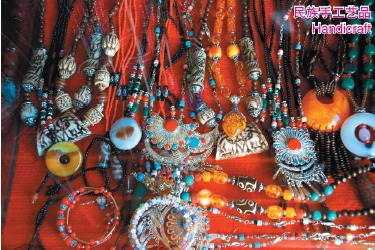
As one of the 5 large pasture regions, Tibet has 82.07 million mu of grassland. Animal agriculture is the main industry in Tibet, the income of which accounting for 1/3 of the total national income of Tibet.
Mineral Resources
Among all the 160 types of mineral resources, 101 types can be found in Tibet, 40 types of which are with proven reserves. The reserves ranking the top 10 include chrome, copper, volcanic ash, magnetite, mica, boron, arsenic, turf, and molybdenum.
(v)Characteristic Industry
Tourism
In 2004, Tibet served 1.8006 million person-times from home or abroad, with a total tourism income of 1.93 billion yuan.
Mineral
Industry By the end of 2005, the valid certifications for the rights of exploration approved by Tibet reached 899, the mining rights 219.
Tibetan Medicine
At present, 16 Tibetan Medicine enterprises passed the alteration of the GMP. And part of Tibetan Medicine enterprises have set up medicine material growing base in Lhasa, Nyingchi, Miling, Damshung, etc.
Agriculture Processing
Industry In 2005, the production value of rural enterprises in Tibet was 1.8 billion yuan. The market leader enterprises of the industrialized agriculture production developed very fast and steadily, in which the Lhasa Beer Company Corp., Tibetan Highland-treasure Yak Corp, Longhu
Industry and Trade Corp. were awarded as the national market leader enterprises, and the other 13 enterprises such as Tibetan Sunshine Biology Corp., the shannan yayan feedstuff Corp., and the Tibetan Medicine Corp were awarded as the regional market leader enterprises. The number of county-level and local market leader enterprises reached over 50. The balanced development pattern of different level of market leader enterprises and the industrialized operation of agriculture is initially formed.
Handicrafts Industry
The handicrafts industry includes production of gold, silver, iron, copper, wood and stones, construction, painting and sculpture, textile, shoe making, and leather manufacture. And the main products include carpet, racial costume, furniture made of iron and wood, Tibetan quilt, jewelry made of gold and silver, apron, wares made of gold, silver and copper, broadsword, leather product, wood bowl, etc. According to statistics, the handicrafts enterprises registered in Tibet are more than 100. And the product value of light textile enterprises reaches 1.15 billion yuan.
Construction and Building Material Industry
In 2005, the added-value of construction industry of Tibet was 5.2 billion yuan; and the product value of building material industry reached about 1 billion yuan.
Related Articles:
Doing Business in TAR of China: Survey
Doing Business in TAR of China: Investment
Doing Business in TAR of China: Development Zones





